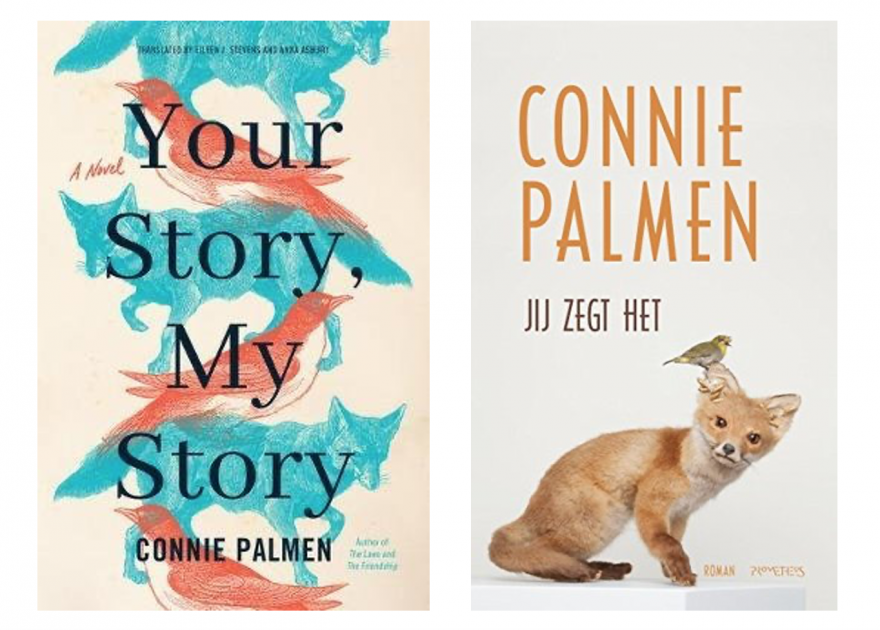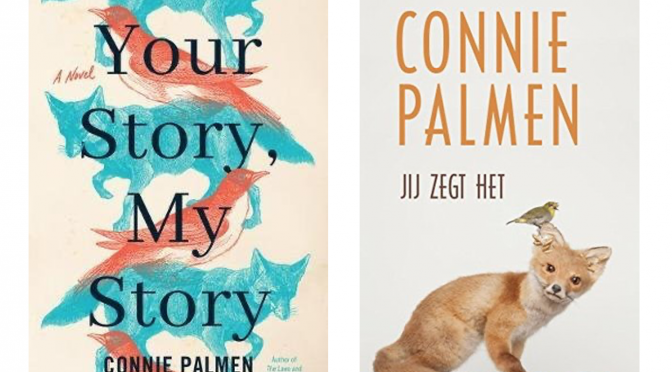by Sylvia Solakidi


In this blog, King’s graduate Sylvia Solakidi explores the role of betrayal in the quest for love and knowledge in Connie Palmen’s novel about the contentious romance of Ted Hughes and Sylvia Plath.
For Λ
They tried to save a little bird; it was suffering, they gave it “the kindest death”. “Gas would be the kindest death”, she said.
On a bridge in London, he saw himself as a child in the face of a man who sold him a fox cub. He walked away; from the fox, from his own self, from his being with her.
She gave herself “the kindest death”. In the mortuary, he identified her as Sylvia Hughes Plath, the wife of Ted Hughes; his silent voice was screaming: “I am guilty, I”.
The bird and the fox hunt the story of love between the American poet Sylvia Plath and the British poet Ted Hughes in Your Story, My Story, the 2015 novel by the Dutch writer Connie Palmen that is now published in English. Their love was a Janus with two faces; its other face was that of an “all-consuming violence”, like their “cruel” first bite-kiss, that “hurt”, and was “real”. For her, “love and hate were so close that they were practically the same”. The devouring face turned their love into a “real” transformative force; “an explosive collision of astral energy that would change my life forever”, he says.
Who says that?
Ted Hughes says that. This novel is his story of their love; how he found his “doppelgänger”, his other self, in her; how love transformed them into the two faces of a Janus, symbiotic couple; how their shared corporeal and emotional vulnerability, their fears and needs, were paired with the quest for their poetic voices; how symbiosis finally suffocated them and the true and real being of the couple was displaced by the split into their separate existences. How her suicide was “a death with an addressee”; “her death is my death”, he says. He, who met his “own demons” by listening to “her wolves”, he, who made her madness his, he, who participated in her death, tells his story; it is not just his story, it is her story too. The “one body, one spirit, one marriage of language” that they once shared, returns in this story.
He does not speak her name, he uses pronouns; “my” not as a possessive but as a symbiotic expression of what grief can keep from their shared self that is gone. “My” is “her”, “I” is “she”; “her name is my name”, he says. Their names are only heard once, when they call each other for the first time. Heard, not read? In this novel his voice is heard; Hughes tells his story as an uninterrupted monologue composed of prose poems. Is it an inner monologue? Is it a stream of consciousness? Rather not. He is in search of the genuine; in each prose poem he explores different aspects of what is real and true in self, in poetry, in being, in her personality, in their story. He performs this exploration by touching upon their Janus, symbiotic love, the most genuine experience of his life, as he tries to understand how she wanted to address him with her suicide; he takes the stage.
Who says that?
Connie Palmen, his writer, says that. In interviews she has described her novel as a theatrical monologue. I understand why. When I was a student at the Department of English at King’s College London I first came to know about performative writing, the writing that does not explain, does not analyse, does not argue, does not describe its topic, but makes it happen through its style and form; no form-content divide in Palmen’s novel, as the Janus couple is reflected in her Janus writing of a novel that takes the stage. She creates her character, Ted Hughes, as a “powerless magician” who cherishes myths and dreams, and practices hypnosis, astrology, tarot and Ouija tables, in search of “the holy time”, the time of creativity; not only for himself, since his “highest act of love” is to liberate Sylvia Plath’s genuine voice, which was trapped in her masked, introvert self, and to make it heard in her poetry. A strong but fleeting bond was created then; “you have too much power over me”, she said.
“I did not know”; “I had no idea”.
Who says that?
Ted Hughes says that; in the novel he repeats his ignorance before catastrophe, as he does in Birthday Letters, the poems addressed to Plath that he published shortly before his death.
Connie Palmen says that; in the Logbook of a Merciless Year, her 2011 book recording her grief after the death of her husband, the Dutch politician Hans van Mierlo. She was about to start her new novel when he died. Their love was symbiotic, with shared dependence and fear of abandonment; like the love of Plath and Hughes. When he died, the proximity to the beloved body was necessary for her to say goodbye; like Hughes, who needed to go to dead Plath. While in pain from the loss, she was tortured by shame that she had outlived him; like Hughes, who was ashamed that he survived, while Plath had committed suicide.
Unlike Plath and Hughes, Palmen and van Mierlo passed what “would seriously test any marriage” as they shared for two years a small, narrow bed, the symbol of their love in her Logbook; their symbiosis never suffocated them and only death separated them. When her man was rolling over on this small bed, he was moving her with him; she was a part of his own body, they had a genuine bond. When he died, life for her was “ingenuine”, as she writes in the Logbook; like Hughes, she felt that her body was “half amputated”. The other face of the Janus symbiotic love is the violence of loss; the pain of loss is another aspect of its transformative power. In her 1995 novel The Friendship, Palmen states that “writing is giving your mind another body”. When the pain of grief overwhelmed her existence, her body did not allow her to switch into another body and write a novel; she wrote the book of grief, instead, the Logbook, which is unique in her oeuvre. As time went by, she was able to liberate herself from the restriction of her own pain and opened up towards the experience of Hughes; she gave his body to her mind and she wrote Your Story, My Story, the novel that addresses grief, the genuine symbiotic self and the loss of genuine existence when symbiosis is gone.
In search of her own “holy time” of creativity, Palmen found her “doppelgänger”, Ted Hughes. She creates a symbiotic relationship with him in language; his story is her story. His voice speaks a monologue in which Palmen integrates variations of his own verses, mostly from Birthday Letters, as well as images and ideas explored in her novels and her essays on her poetics of writing; “holy time”, is one of them. The result is a voice that reminds intensely of Hughes’s poetic style and rhythm, without being entirely his; a Janus voice of Hughes and Palmen shaped by different experiences of loss that performs in language the Janus symbiotic couple whose story Palmen writes. The writer’s major achievement is also the major achievement of the translators who brought back into English the style and rhythm of Hughes that Palmen had translated into Dutch by marrying it to her own.
As the bond with Plath fades, Hughes shifts the pronouns from the symbiotic “my” to the possessive “their”; “they” are the biographers, who have known the names of the famous couple and reduced their love into cliché stories. His name, that Plath spoke as an acknowledgement of his existence, “robs (him) of (his) freedom”, his freedom to speak; he remained silent. In their stories, she was “the brittle saint” and he was “the brutal traitor”.
“Woe to the one by whom (s)he is betrayed”.
Who says that?
The Gospel according to Matthew says that. “Truly I tell you, one of you will betray me”, said Jesus. “Surely not I, Rabbi?”; “You have said so”, was Jesus’s reply to Judas.
“I would write a novel called Judas, and then my man died”; this is the beginning of the Logbook of a Merciless Year. In the novels that Palmen has been writing since 1991, she often shapes her own intimate experience by contemplating it in an abstract way, in order to relate it to a story that is recurrent in literature. The result is not an autobiography, but a novel written in “an autobiographical style”, as she explains in her essays about her poetics of writing. She uses biographical material of others in the same way; in Hughes’s life she sees the story of the prototypical traitor, of Judas. Judas stands for the ultimate evil; yet, he is essential for the salvation of the world, since there would be no Resurrection of Jesus without his betrayal. Judas is a Janus with two faces and in her Logbook, the diary-like record that intervened into the creative process of her novel, Palmen reflects upon “betrayal as the necessary condition for knowledge” and as “the essence of literature”, by referring to the writing of an intimate journal; this is the face of the writer. Your Story, My Story is not a biography but a Judas novel, in which the name of Judas in never mentioned; its Dutch title, though, is Jij zegt het, which means You have said so.
Palmen offers Hughes the opportunity to transform himself from “brutal traitor” into genuine traitor. This “powerless magician” is in search of the “holy time” of betrayal and becomes an alchemist who marries the opposites, creativity and violence. He reveals the ineffable knowledge from his love by betraying it out of love; he transforms the genuine symbiotic bond into genuine knowledge. The monologue is not his defence. “The judge acquitted me. I didn’t acquit myself”, he says; he has already condemned himself. In Palmen’s novel he is judged by his painful process from the title’s “You have said so” to his final words “And I said that, I”. He is judged by the process through which he reaches this final “I”; it is the “I” of the writer, who is speaking up and writing his story; it is the symbiotic “I” of the responsibility to Plath, so that their love may never be forgotten; it is the “I” that opens up towards his audience, by offering them the knowledge of the Janus, symbiotic love, to his audience that will be the ultimate judges of his story, of her story.
Who says that?
Thanks to a happy coincidence I read Dutch.
Thanks to another happy coincidence, I have come across Connie Palmen’s oeuvre; and I have been enchanted by it. In this piece, I become a traitor of the kind of love that Palmen writes about in Your Story, My Story, out of love for this novel; I give you the knowledge of what lies behind the title of the English translation, by exploring Palmen’s books that have not been translated into English yet.
Thanks to another happy coincidence, I met my dearest friend, to whom this piece is dedicated. Sylvia Plath is her favourite poet and one of the first things she asked me was whether I like her; she made this association because my name is Sylvia. I confessed my ignorance; “we do need to correct this”, she said. The ignorant read Plath’s collective poems and The Bell Jar in a week, and my friend said that Hughes is a great poet as well, but no, I do not need to spend the following week reading him. The ignorant read Hughes during the couple of weeks that followed her reading of Your Story, My Story in Dutch, the story of Jesus and Judas, traitor and writer, love and violence, symbiosis and loss, Hughes and Palmen, “her” and “him” – “Sylvia” and “Ted”, “Connie” and “Hans”; a story worth reading.
And I say that, I.
Connie Palmen Your Story, My Story, (trans: Eileen Stevens and Anna Asbury), Amazon Crossings: 2021
Connie Palmen’s web site (in several languages, including English): conniepalmen | Schrijver
Connie Palmen reads the passage on violence in Dutch with English subtitles and discusses her book in English (it starts at 20:20): The Limits of Empathy – Writers Unlimited – Winternachten festival Den Haag 2016 – YouTube
Blog posts on King’s English represent the views of the individual authors and neither those of the English Department, nor of King’s College London.
You may also like to read:

